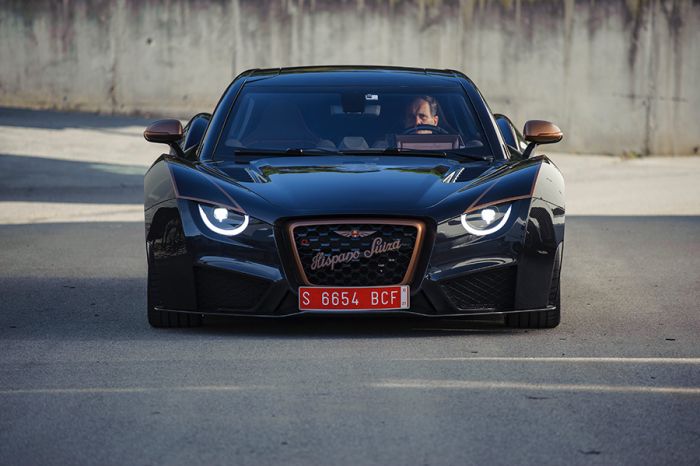Hispano Suiza has launched a second model, the Carmen Boulogne, a sportier evolution of the iconic Carmen. The Carmen Boulogne is a fully electric and exclusive hypercar designed, developed and manufactured in Barcelona (Spain), of which only five will be made.
The Boulogne name dates back to 1921, when Hispano Suiza made a racing version of its high-performance H6 Coupé and entered it in the George Boillot Cup, an endurance race lasting more than 3.5 hours around the French city of Boulogne. There, Hispano Suiza achieved three consecutive victories with André Dubonnet (1921), Paul Bablot (1922) and Léonce Garnier (1923) driving the mighty Hispano Suiza H6.
The Hispano Suiza Carmen Boulogne pays tribute to these historic motorsport victories with this powered version that delivers 1114 CV (820 kW) - 95 CV more than the Hispano Suiza Carmen - a maximum speed limited to 290 km/h and an acceleration of 0-100 km/h in just 2.6s. The Hispano Suiza Carmen Boulogne weighs 1,630 kg, 60 kg less than the Carmen. This reduction has been achieved thanks to the optimisation of structural elements such as the suspension, the carbon fibre subframe, new CNC parts and a carbon fibre roof, among other things.
The Carmen Boulogne is powered by four permanent-magnet synchronous engines, two on each rear wheel. The torque of each engine is controlled through sophisticated vectoring systems developed in-house with the expertise gained in Formula E. From 0 to 6,500 rpm, the engines are capable of reaching a maximum of 1,600 Nm of torque, allowing for astonishing acceleration and seemingly endless power and traction. The lithium-ion polymer battery has a capacity of 80 kWh that allows it to develop a driving range of up to 400 km. The batteries are designed and produced in-house, including a complete temperature control system to ensure that the cells can operate optimally. It has a fast-charging capacity of more than 80 kW DC, requiring only 30 minutes to charge 30-80% through a CCS2 fast charger. It also has CHAdeMO and GB/T charging options.
The entire body of the Carmen Boulogne is made of carbon fibre, visible under a clear varnish that emphasizes its sportiness and preserves the timeless elegance of this model. It sports the same semi-circular headlights and aggressive "scowl" as the Carmen, with the difference of an imposing copper-coloured grille.
The Carmen Boulogne is a fully customizable model thanks to the brand's 'Unique Tailormade' department. Its sleek interior features suede or black Alcantara on the bulkhead and door panels.
The design, engineering and production is the result of the expertise of Hispano Suiza and QEV Technologies, a company specializing in the development of electric motors and motorsports.
The price of the Hispano Suiza Carmen Boulogne starts from 1.65 million euros (plus local taxes), and its manufacturing process, handmade with the utmost precision, requires approximately twelve months.
The five units of the Carmen Boulogne hypercar join the 14 units of the Carmen to reach a total of 19 units in production, with the first unit ready to be delivered in 2022.
EDITOR'S NOTE: The constant presentation of electric super-sports, which will sell at exorbitant prices, produces contradictory thoughts in my mind. On the one hand, technological advances have always been introduced first in special and very expensive cars - the only ones that justify so much investment - and then these technologies have been perfected for use in more common and therefore cheaper vehicles. This is a very positive development. But on the other hand, one wonders why so many supercars, which will be produced in very, very limited series and at prices beyond a million euros, and for whom are these models. Who can afford them? And we are faced with the ethical doubt that is currently gaining strength once again with regard to the fact that society is splitting up into the super-rich and ... the rest, currently killing off all the middle and upper-middle classes. Do we not thereby support something that we deeply detest, that the rich are getting richer every day without contributing much to society? Well, that's where we leave the issue; everyone is free to express his or her opinion on it.
Just one more note: we do not forget that Hispano-Suiza's predecessor, the company Emilio de la Cuadra, prepared the first electric vehicles in Spain as early as 1898 with the help of three Swiss, Vélino, Bouvier and Birkigt - see my reports on this fascinating story. I would also like to remind the reader that the first electric bus developed by this company in 1899 did work satisfactorily, as can be demonstrated through notes published in the press at the time, praising these purely Spanish products.

26 November 2020
The new Hispano Suiza Carmen Boulogne on the road
by

